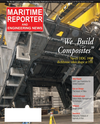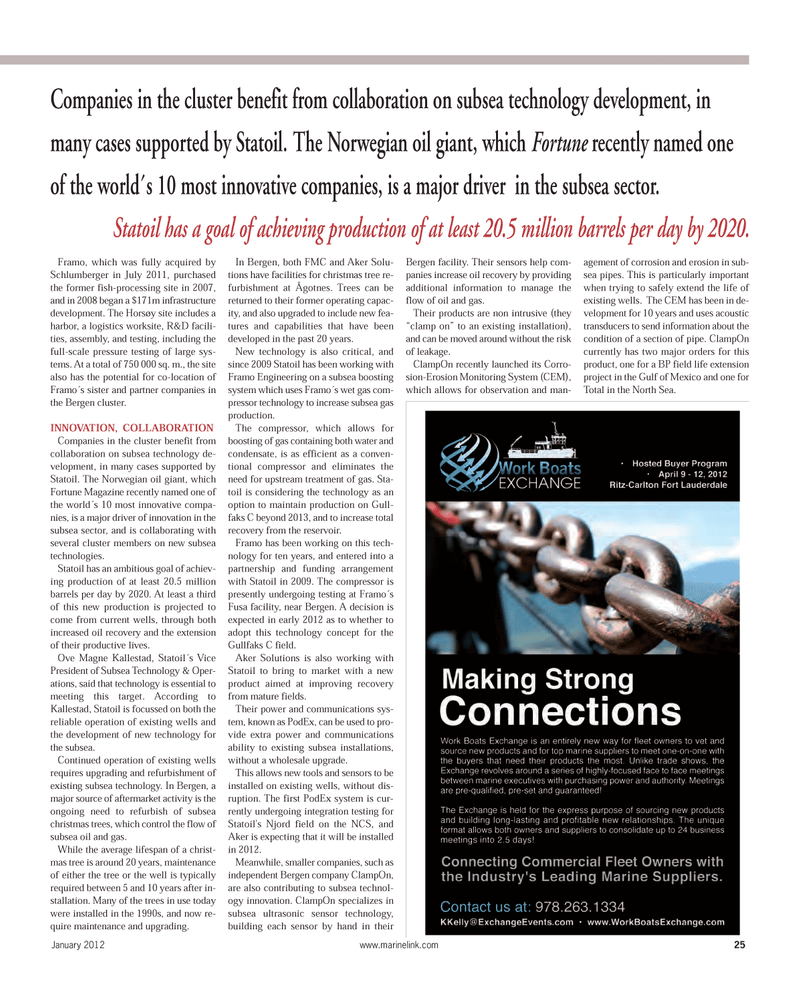
Page 25: of Maritime Reporter Magazine (January 2012)
US Navy Report
Read this page in Pdf, Flash or Html5 edition of January 2012 Maritime Reporter Magazine
Framo, which was fully acquired by Schlumberger in July 2011, purchased the former fish-processing site in 2007, and in 2008 began a $171m infrastructure development. The Horsøy site includes a harbor, a logistics worksite, R&D facili- ties, assembly, and testing, including the full-scale pressure testing of large sys- tems. At a total of 750 000 sq. m., the site also has the potential for co-location ofFramo´s sister and partner companies inthe Bergen cluster. INNOVATION, COLLABORATION Companies in the cluster benefit from collaboration on subsea technology de-velopment, in many cases supported by Statoil. The Norwegian oil giant, which Fortune Magazine recently named one of the world´s 10 most innovative compa- nies, is a major driver of innovation in the subsea sector, and is collaborating with several cluster members on new subsea technologies. Statoil has an ambitious goal of achiev- ing production of at least 20.5 millionbarrels per day by 2020. At least a third of this new production is projected to come from current wells, through bothincreased oil recovery and the extension of their productive lives. Ove Magne Kallestad, Statoil´s Vice President of Subsea Technology & Oper- ations, said that technology is essential tomeeting this target. According to Kallestad, Statoil is focussed on both thereliable operation of existing wells and the development of new technology for the subsea. Continued operation of existing wells requires upgrading and refurbishment ofexisting subsea technology. In Bergen, a major source of aftermarket activity is the ongoing need to refurbish of subseachristmas trees, which control the flow of subsea oil and gas. While the average lifespan of a christ- mas tree is around 20 years, maintenanceof either the tree or the well is typicallyrequired between 5 and 10 years after in-stallation. Many of the trees in use today were installed in the 1990s, and now re- quire maintenance and upgrading. In Bergen, both FMC and Aker Solu- tions have facilities for christmas tree re- furbishment at Ågotnes. Trees can be returned to their former operating capac-ity, and also upgraded to include new fea- tures and capabilities that have been developed in the past 20 years. New technology is also critical, and since 2009 Statoil has been working with Framo Engineering on a subsea boostingsystem which uses Framo´s wet gas com- pressor technology to increase subsea gas production. The compressor, which allows for boosting of gas containing both water and condensate, is as efficient as a conven- tional compressor and eliminates theneed for upstream treatment of gas. Sta- toil is considering the technology as anoption to maintain production on Gull-faks C beyond 2013, and to increase total recovery from the reservoir. Framo has been working on this tech- nology for ten years, and entered into apartnership and funding arrangementwith Statoil in 2009. The compressor is presently undergoing testing at Framo´s Fusa facility, near Bergen. A decision is expected in early 2012 as to whether to adopt this technology concept for theGullfaks C field. Aker Solutions is also working with Statoil to bring to market with a new product aimed at improving recovery from mature fields. Their power and communications sys- tem, known as PodEx, can be used to pro- vide extra power and communications ability to existing subsea installations, without a wholesale upgrade. This allows new tools and sensors to be installed on existing wells, without dis- ruption. The first PodEx system is cur- rently undergoing integration testing for Statoil's Njord field on the NCS, and Aker is expecting that it will be installed in 2012. Meanwhile, smaller companies, such asindependent Bergen company ClampOn, are also contributing to subsea technol- ogy innovation. ClampOn specializes in subsea ultrasonic sensor technology, building each sensor by hand in their Bergen facility. Their sensors help com- panies increase oil recovery by providing additional information to manage theflow of oil and gas. Their products are non intrusive (they ?clamp on? to an existing installation), and can be moved around without the risk of leakage. ClampOn recently launched its Corro- sion-Erosion Monitoring System (CEM),which allows for observation and man- agement of corrosion and erosion in sub-sea pipes. This is particularly important when trying to safely extend the life of existing wells. The CEM has been in de- velopment for 10 years and uses acoustic transducers to send information about thecondition of a section of pipe. ClampOncurrently has two major orders for this product, one for a BP field life extension project in the Gulf of Mexico and one for Total in the North Sea. January 2012www.marinelink.com 25Companies in the cluster benefit from collaboration on subsea technology development, in many cases supported by Statoil. The Norwegian oil giant, which Fortune recently named one of the world´s 10 most innovative companies, is a major driver in the subsea sector. Statoil has a goal of achieving production of at least 20.5 million barrels per day by 2020. MR Jan.12 # 3 (18-25):MR Template 1/9/2012 11:59 AM Page 25

 24
24

 26
26
